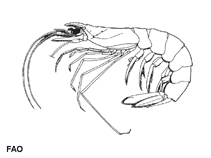Haliporoides sibogae (De Man, 1907)
Jack-knife shrimp| Native range | All suitable habitat | Point map | Year 2050 |

|
| This map was computer-generated and has not yet been reviewed. |
| Haliporoides sibogae AquaMaps Data sources: GBIF OBIS |
Classification / Names Common names | Synonyms | CoL | ITIS | WoRMS
Malacostraca | Decapoda | Solenoceridae
Environment: milieu / climate zone / depth range / distribution range Ecology
Benthic; depth range 100 - 1463 m (Ref. 409), usually 300 - 600 m (Ref. 409). Tropical, preferred 26°C (Ref. 107945); 33°N - 44°S, 103°E - 176°W
Distribution Countries | FAO areas | Ecosystems | Occurrences | Introductions
Indo-West Pacific: Madagascar to Japan and New Zealand (Ref. 8). Pérez Farfante recognizes 3 subspecies: Haliporoides sibogae australiensis from Australia; Haliporoides sibogae madagascariensis from Madagascar and Reunion; and Haliporoides sibogae sibogae from Malaysia to Japan and New Zealand (Ref. 75620).
Length at first maturity / Size / Weight / Age
Maturity: Lm ?, range 10 - ? cm Max length : 16.5 cm BL male/unsexed; (Ref. 8); 20 cm BL (female)
Both midwater and demersal species (Ref. 106892). Deep water species (Refs. 82143, 106892). On rocks and rubbles (Ref .99823). Reported to undertake diel vertical migrations; may also bury in the continental slope at night. Feeds almost exclusively on bottom-living prey; actively hunting both night and day (Ref. 106892).
Life cycle and mating behavior Maturity | Reproduction | Spawning | Eggs | Fecundity | Larvae
Members of the order Decapoda are mostly gonochoric. Mating behavior: Precopulatory courtship ritual is common (through olfactory and tactile cues); usually indirect sperm transfer.
Main reference
References | Coordinator | Collaborators
Holthuis, L.B. 1980. (Ref. 8)
IUCN Red List Status (Ref. 130435)
CITES status (Ref. 108899)
Not Evaluated
CMS (Ref. 116361)
Not Evaluated
Threat to humans
Human uses
Fisheries: commercial
FAO - Fisheries: landings | FishSource | Sea Around Us
Tools
More information
Internet sources
BHL | BOLD Systems | CISTI | DiscoverLife | FAO(Fisheries: ; publication : search) | Fishipedia | GenBank (genome, nucleotide) | GloBI | Gomexsi | Google Books | Google Scholar | Google | PubMed | Tree of Life | Wikipedia (Go, Search) | Zoological Record
Estimates based on models
Preferred temperature
(Ref. 115969): 6.8 - 13.8, mean 9.8 (based on 601 cells).
Resilience
(Ref. 69278):
High, minimum population doubling time less than 15 months (K=0.37-1.74).
Prior r = 0.96, 95% CL = 0.63 - 1.43, Based on 1 data-limited stock assessment.
Price category
(Ref. 80766):
Unknown.
Nutrients: Calcium = 109 [35, 184] mg/100g; Iron = 1.59 [1.21, 1.97] mg/100g; Protein = 20.2 [19.2, 21.3] %; Omega3 = 0.285 [0.185, 0.386] g/100g; Selenium = 48.3 [-31.7, 128.3] μg/100g; VitaminA = 0 μg/100g; Zinc = 1.79 [1.17, 2.40] mg/100g (wet weight).



